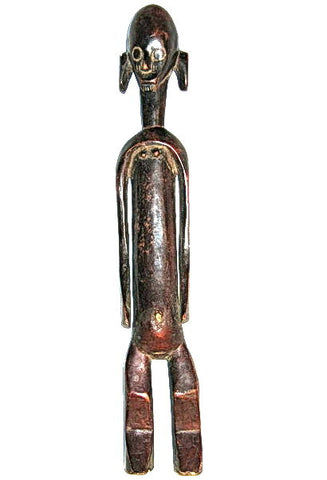ArtTribal.com
Mumuye Human Figure
ArtTribal.com
Email vera@arttribal.com for shipping outside of continental US
The Mumuye statuary was discovered in 1968. Even though the Mumuye show great respect for the sculls of the ancestors, their statuary does not depict ancestors, but rather incarnates tutelary spirits. Yet, statues reinforce the status and prestige of their owner who, as he holds them in his hands, has a dialogue with them and thus ensures his personal protection. The functions of sculptural figures are varied. They were used by both diviners and healers, whose professions included diagnosis and cure of ill health and other kinds of misfortunes.
The figures were used to greet rainmaker's clients, guard the house, serve as owner's confidant, and in trials when men in dispute swear on the statue, which they must kiss. Elders used them to reinforce their status in society. It was not unusual for a figure simultaneously to serve two or more functions. Mumuye figures are highly abstracted, perhaps in part because they invoke forms of human and supernatural authority. The statues’ principal characteristic, unique in African art, is the openwork between the body and the arms, which forms a scroll or a spiral around the slender, cylindrical bust. The legs are usually angular, and ribbon-like arms wrap around the torso with elbows clearly marked. The heads may display a coiffure in the form of a crest. A number of such sculptures have large ears with pierced and distended earlobes for the insertion of plugs. The Mumuye distinguish the gender of the figures on the basis of the shape of the ears; only Mumuye women distend their earlobes. This may be the only clue to determining the gender of a figure.
This figure has been in the Raskin Private collection for many years
http://www.zyama.com/mumuye/
Product Details:
- Size: 25" x 6" x 4"
- Shipping: 80.00
- Material: Wood
- Quantity: 1 available in stock
- SKU: #MUMUYE01

